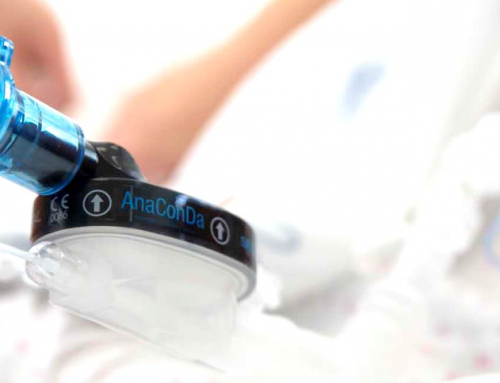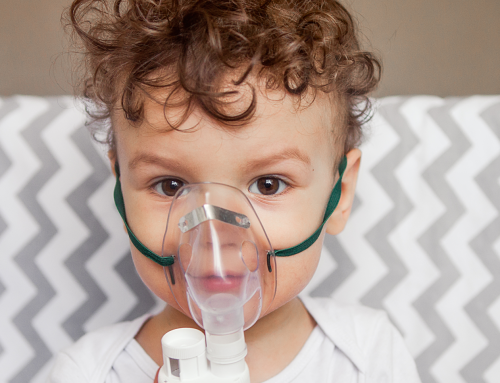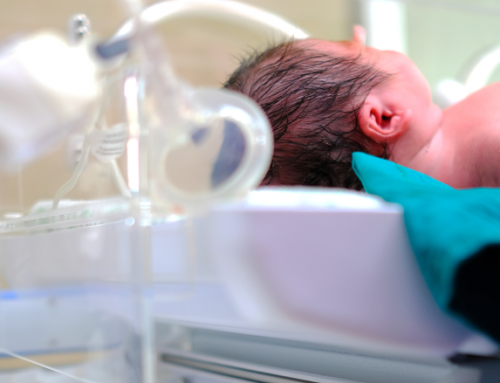
Louise Lake, BSc SRT
Respiratory distress syndrome (RDS) is a condition found in premature infants that is characterised by surfactant deficiency, underdeveloped alveolar units and capillaries, reduced lung compliance, and poor gas exchange. It affects over 40,000 premature infants in the United States every year, with the incidence and severity of the disorder increasing with decreasing gestational age and birth weight (Kacmarek, Stoller & Heuer, 2020). RDS is the most common respiratory disorder in premature infants, though mortality rates have decreased significantly over the past 60 years in high-income countries like the United States and Canada. However, it is still a major contributor to neonatal mortality worldwide, especially in low-income countries such as India (Kamath, MacGuire, McLure, Goldenberg & Jobe, 2011). Most often, RDS is treated using continuous positive airway pressure (CPAP), surfactant replacement therapy, and mechanical ventilation with conventional or high frequency ventilation (Kacmarek et al., 2020). While these techniques are the ones most often used, there is ongoing research into alternative or supplementary methods for the treatment of RDS, such as that conducted by Elfarargy, Elsharaby, Younis & Abu-Risha (2020).
Summary of Research
Elfarargy et al. (2020) performed a prospective randomized clinical trial on 100 cases of neonates suffering from RDS to determine if supplementation with melatonin would affect a range of clinical outcomes. The infants were divided into two groups of 50, with the experimental group receiving melatonin supplementation in addition to respiratory support and the control group receiving respiratory support only. Those receiving the melatonin supplementation were given 10mg/kg a day for five days. The researchers looked at the differences between the two groups in the grade of RDS, Downe’s score (a clinical score used for the categorization of severity of respiratory distress in neonates), duration of stay in the incubator, need for mechanical ventilation, as well as serum levels of malondialdehyde (MDA), superoxide dismutase (SOD) and interleukin-8 (IL-8) between day one and day five. The grade of RDS and Downe’s scores were recorded to observe changes in the signs and symptoms of RDS and overall respiratory function, while incubator and ventilation requirements were reflective of the need for additional support measures. The authors state that hyperoxia resulting from RDS treatment may lead to the accumulation of reactive oxygen species, causing oxidative stress and cell damage, so serum biomarkers were measured to determine the antioxidant effects of melatonin. In the experimental group, each outcome measured at day five showed a statistically significant decrease compared to the baseline measure at day one. For each of the measures used in this study, a decrease represents a beneficial effect. This same effect was not seen in the control group, meaning that the improvements in RDS and its outcomes can be correlated to the supplementation of melatonin (pp. 196-201).
Relevance to Respiratory Therapy
The results of the research conducted by Elfarargy et al. (2020) have far-reaching benefits beyond that of just an improvement in RDS itself. For example, a recent prospective cohort study on 40 premature infants discovered that “the duration of invasive mechanical ventilation performed in the first 48h (hours) of life in the very low birth weight infants is a significant clinical predictor of bronchopulmonary dysplasia” (Nascimento et al., 2020, p. 2). These results are consistent with a study by Ambalavanan & Carlo (2006) that also looked at the effects of mechanical ventilation in premature infants. It stated that while mechanical ventilation significantly improves the survival rate of infants suffering from RDS and is therefore a lifesaving technique, it might lead to the development of bronchopulmonary dysplasia (BPD). The article goes on to suggest that limiting mechanical ventilation support is one crucial way to prevent the development of BPD. This recommendation highlights the importance of the finding from Elfarargy et al. (2020) that melatonin supplementation decreases the number of RDS cases that require mechanical ventilation. If there are fewer infants in need of mechanical ventilation support, it is likely that fewer will develop BPD. While some studies have shown that there is no difference in the quality of life in children, adolescents, or adults who survived BPD as an infant compared to those who have not suffered from the disorder, other research has been conducted that found an effect on sleep quality, stress, depressive symptoms, and quality of life for the caregivers of young children with BPD (Beaudoin, Tremblay, Croitoru, Benedetti & Landry, 2013; Bozzetto et al., 2016; Feeley et al., 2013; Gray, O’Callaghan & Poulsen, 2008). If melatonin supplementation can limit the number of cases of infants with RDS who develop BPD, it may directly benefit the lives of the parents and caregivers of these children.
Concluding Statements
Respiratory distress syndrome is one of the most severe respiratory conditions in premature infants and is a significant contributor to neonatal morbidity and mortality (Elfarargy et al., 2020). Advances in technology and therapies for the treatment of RDS have drastically reduced the mortality rate associated with the disorder, but now “the aim of management of RDS is to provide interventions that will maximize survival whilst minimizing potential adverse effects” (Sweet et al., 2013, p. 354). Elfarargy et al. (2020) note that in treating RDS, premature neonates are often exposed to high oxygen concentrations for long periods, leading to oxidative stress that damages lipids, proteins, tissues, and DNA. Given this, the researchers developed a randomized control trial to determine the effects of melatonin supplementation on neonates suffering from RDS. The experiment demonstrated that melatonin supplementation was able to significantly decrease not only the serum biomarkers associated with oxidative stress (MDA, SOD, and IL-8), but also the grade of RDS, Downs’ score, length of stay in the incubator, and the need for mechanical ventilation. These findings yield optimistic implications for respiratory therapy practice and the future of RDS treatment. By minimizing the negative outcomes associated with current approaches, a respiratory therapist can focus their efforts more effectively and work towards improving the lives of both the RDS sufferer and their caregivers.
References
Ambalavanan, N., & Carlo, W. A. (2006). Ventilatory strategies in the prevention and management of bronchopulmonary dysplasia. Seminars in Perinatology, 30(4), 192-199. https://doi.org/10.1053/j.semperi.2006.05.006
Beaudoin, S., Tremblay, G. M., Croitoru, D., Benedetti, A., & Landry, J. S. (2013). Healthcare utilization and health-related quality of life of adult survivors of preterm birth complicated by bronchopulmonary dysplasia. Acta Paediatrica, 102(6), 607-612. https://doi.org/10.1111/apa.12217
Bozzetto, S., Carraro, S., Tomasi, L., Berardi, M., Zanconato, S., & Baraldi, E. (2016). Health-related quality of life in adolescent survivors of bronchopulmonary dysplasia. Respirology, 21(6), 1113-1117. https://doi.org/10.1111/resp.12811
Elfarargy, M. S., Elsharaby, R., Younis, R. L., & Abu-Risha, S. (2020). Melatonin supplementation as an adjuvant therapy in neonatal respiratory distress syndrome. Journal of Clinical Neonatology, 9(3), 196-201. https://doi.org/10.4103/jcn.jcn_17_20
Feeley, C. A., Turner-Henson, A., Christian, B. J., Avis, K. T., Heaton, K., Lozano, D., & Su, X. (2014). Sleep quality, stress, caregiver burden, and quality of life in maternal caregivers of young children with bronchopulmonary dysplasia. Journal of Pediatric Nursing, 29(1), 29-38. https://doi.org/10.1016/j.pedn.2013.08.001
Gray, P. H., O’Callaghan, M. J., & Poulsen, L. (2008). Behaviour and quality of life at school age of children who had bronchopulmonary dysplasia. Early Human Development, 84(1), 1-8. https://doi.org/10.1016/j.earlhumdev.2007.01.009
Kacmarek, R. M., Stoller, J. K., Heuer, A. J. (2020). Egan’s fundamentals of respiratory care (12th ed.). Elsevier.
Kamath, B. D., MacGuire, E. R., McClure, E. M., Goldenberg, R. L., & Jobe, A. H. (2011). Neonatal mortality from respiratory distress syndrome: Lessons for low-resource countries. Pediatrics, 127(6), 1139-1146. https://doi.org/10.1542/peds.2010-3212
Nascimento, C. P., Maia, L. P., Alves, P. T., Paula, A. T. de, Cunha Junior, J. P., Abdallah, V. O. S., Ferreira, D. M. de L. M., Goulart, L. R., & Azevedo, V. M. G. de O. (2020). Invasive mechanical ventilation and biomarkers as predictors of bronchopulmonary dysplasia in preterm infants. Jornal de Pediatria, xx. https://doi.org/10.1016/j.jped.2020.03.006
Sweet, D. G., Carnielli, V., Greisen, G., Hallman, M., Ozek, E., Plavka, R., Saugstad, O. D., Simeoni, U., Speer, C. P., Vento, M., & Halliday, H. L. (2013). European consensus guidelines on the management of neonatal respiratory distress syndrome in preterm infants – 2013 update. Neonatology, 103, 353-368. https://doi.org/10.1159/000349928
[printfriendly]





